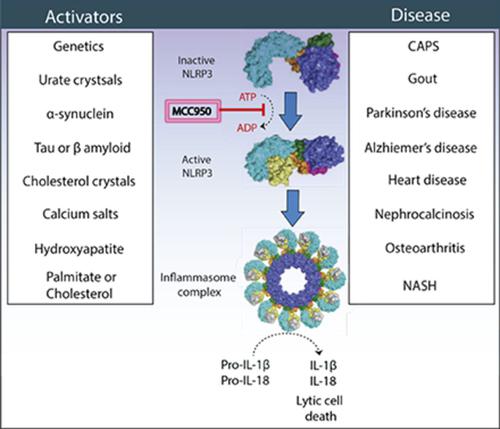当前位置:
X-MOL 学术
›
Pharmacol. Rev.
›
论文详情
Our official English website, www.x-mol.net, welcomes your
feedback! (Note: you will need to create a separate account there.)
Pharmacological Inhibition of the Nod-Like Receptor Family Pyrin Domain Containing 3 Inflammasome with MCC950
Pharmacological Reviews ( IF 19.3 ) Pub Date : 2021-07-01 , DOI: 10.1124/pharmrev.120.000171 Sarah E Corcoran 1 , Reena Halai 1 , Matthew A Cooper 2
Pharmacological Reviews ( IF 19.3 ) Pub Date : 2021-07-01 , DOI: 10.1124/pharmrev.120.000171 Sarah E Corcoran 1 , Reena Halai 1 , Matthew A Cooper 2
Affiliation

|
Activation of the Nod-like receptor family pyrin domain containing 3 (NLRP3) inflammasome drives release of the proinflammatory cytokines interleukin (IL)-1β and IL-18 and induces pyroptosis (lytic cell death). These events drive chronic inflammation, and as such, NLRP3 has been implicated in a large number of human diseases. These range from autoimmune conditions, the simplest of which is NLRP3 gain-of-function mutations leading to an orphan disease, cryopyrin-associated period syndrome, to large disease burden indications, such as atherosclerosis, heart failure, stroke, neurodegeneration, asthma, ulcerative colitis, and arthritis. The potential clinical utility of NLRP3 inhibitors is substantiated by an expanding list of indications in which NLRP3 activation has been shown to play a detrimental role. Studies of pharmacological inhibition of NLRP3 in nonclinical models of disease using MCC950 in combination with human genetics, epigenetics, and analyses of the efficacy of biologic inhibitors of IL-1β, such as anakinra and canakinumab, can help to prioritize clinical trials of NLRP3-directed therapeutics. Although MCC950 shows excellent (nanomolar) potency and high target selectivity, its pharmacokinetic and toxicokinetic properties limited its therapeutic development in the clinic. Several improved, next-generation inhibitors are now in clinical trials. Hence the body of research in a plethora of conditions reviewed herein may inform analysis of the potential translational value of NLRP3 inhibition in diseases with significant unmet medical need.
中文翻译:

用 MCC950 对含有 3 个炎性体的 Nod 样受体家族 Pyrin 结构域进行药理学抑制
激活含有 3 (NLRP3) 炎性体的 Nod 样受体家族 pyrin 结构域驱动促炎细胞因子白细胞介素 (IL)-1 β的释放和 IL-18 并诱导细胞焦亡(裂解细胞死亡)。这些事件驱动慢性炎症,因此,NLRP3 与大量人类疾病有关。这些范围从自身免疫性疾病(其中最简单的是导致孤儿疾病的 NLRP3 功能获得性突变、冷冻吡啶相关期综合征)到大的疾病负担适应症,如动脉粥样硬化、心力衰竭、中风、神经退行性变、哮喘、溃疡性结肠炎和关节炎。NLRP3 抑制剂的潜在临床效用已被不断扩大的适应症列表所证实,在这些适应症中,NLRP3 激活已被证明起有害作用。在非临床疾病模型中使用 MCC950 结合人类遗传学、表观遗传学研究 NLRP3 的药理学抑制作用,并分析 IL-1 生物抑制剂的功效β,如 anakinra 和 canakinumab,可以帮助优先考虑 NLRP3 导向疗法的临床试验。尽管 MCC950 显示出优异的(纳摩尔)效力和高靶向选择性,但其药代动力学和毒代动力学特性限制了其在临床上的治疗发展。几种改进的下一代抑制剂目前正在进行临床试验。因此,本文回顾的大量条件下的研究可能有助于分析 NLRP3 抑制在具有重大未满足医疗需求的疾病中的潜在转化价值。
更新日期:2021-06-13
中文翻译:

用 MCC950 对含有 3 个炎性体的 Nod 样受体家族 Pyrin 结构域进行药理学抑制
激活含有 3 (NLRP3) 炎性体的 Nod 样受体家族 pyrin 结构域驱动促炎细胞因子白细胞介素 (IL)-1 β的释放和 IL-18 并诱导细胞焦亡(裂解细胞死亡)。这些事件驱动慢性炎症,因此,NLRP3 与大量人类疾病有关。这些范围从自身免疫性疾病(其中最简单的是导致孤儿疾病的 NLRP3 功能获得性突变、冷冻吡啶相关期综合征)到大的疾病负担适应症,如动脉粥样硬化、心力衰竭、中风、神经退行性变、哮喘、溃疡性结肠炎和关节炎。NLRP3 抑制剂的潜在临床效用已被不断扩大的适应症列表所证实,在这些适应症中,NLRP3 激活已被证明起有害作用。在非临床疾病模型中使用 MCC950 结合人类遗传学、表观遗传学研究 NLRP3 的药理学抑制作用,并分析 IL-1 生物抑制剂的功效β,如 anakinra 和 canakinumab,可以帮助优先考虑 NLRP3 导向疗法的临床试验。尽管 MCC950 显示出优异的(纳摩尔)效力和高靶向选择性,但其药代动力学和毒代动力学特性限制了其在临床上的治疗发展。几种改进的下一代抑制剂目前正在进行临床试验。因此,本文回顾的大量条件下的研究可能有助于分析 NLRP3 抑制在具有重大未满足医疗需求的疾病中的潜在转化价值。











































 京公网安备 11010802027423号
京公网安备 11010802027423号